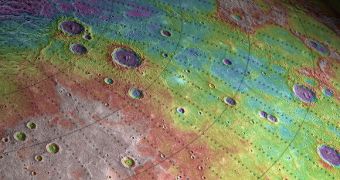Data relayed back to Earth by the NASA MErcury Surface, Space ENvironment, GEochemistry and Ranging (MESSENGER) orbiter suggest that the innermost planet in the solar system had a very rough history, which led it to display a very weird internal structure.
In fact, scientists say, no other planet in the solar system has a core that can compare with Mercury's.
While previous studies had suggested that the object has a very large iron core – which was unusual in itself – the new data appear to suggest that the metallic core is even larger than originally estimated.
What's more, MESSENGER also found that the iron sphere is most likely covered in a solid chemical shell, made up of iron and sulfur. On Earth, the molten inner core is surrounded by a denser, less hot outer core, which is itself enveloped in the mantle. Atop these layers sits the crust.
An additional factor that puzzles researchers is that the planet appears to have remained geologically active for most of its history. Mercury is thought to have evolved around the same time all other planets did, some 4.5 billion years ago.
Observations conducted elsewhere in the solar system suggest that this not a common occurrence. Mars once had an active core as well, but a series of catastrophic events shut it down, turning a planet that may have once supported life into a desolate wasteland.
“Many scientists expected Mercury, being a small planet only slightly larger than the moon, to have cooled off not long after it formed and to be essentially 'dead' for most of its evolution,” scientist Maria Zuber explains.
“But it appears that Mercury had an exciting and active middle age,” adds the expert, who is based at the Massachusetts Institute of Technology (MIT), in Cambridge. She was the lead author of a study based on the MESSENGER data, and coauthor of another.
Zuber tells Space in an email that “it is not out of the question that Mercury is still active today.” She also mentions that the possibility is somewhat remote, and made even slimmer by the fact that not active volcanic eruptions or other geological phenomena were ever observed on the planet.
“With new data, we are continually reminded that when you think you know what's going on you probably don't. Nature is more perplexing than we can possibly conceive,” Zuber concludes.

 14 DAY TRIAL //
14 DAY TRIAL //